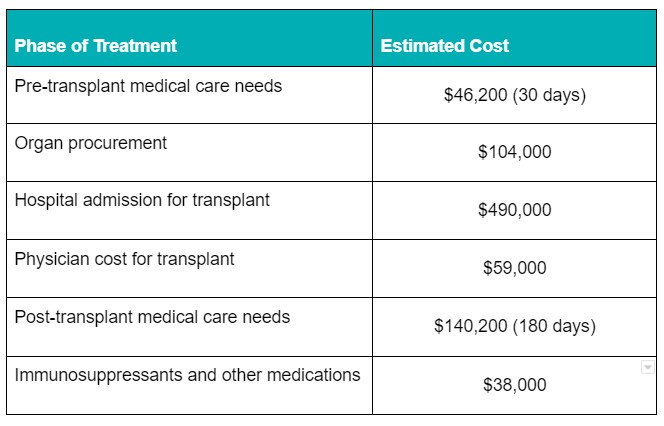A liver transplant offers a beacon of hope for individuals facing end-stage liver disease. However, the financial burden associated with this life-saving procedure can be overwhelming. This article breaks down the costs associated with a liver transplant, explores options for financial assistance, and highlights the importance of fundraising.
Understanding the Financial Landscape of Liver Transplants
The expenses linked to a liver transplant can quickly accumulate, creating a significant obstacle for patients and their families. From pre-transplant evaluations to post-transplant care and lifelong medications, it’s crucial to understand the financial implications involved.
According to a 2020 study by Milliman, the average cost of a liver transplant is approximately $878,400 before insurance. This comprehensive figure encompasses various stages of the transplant process:
 Breakdown of liver transplant costs
Breakdown of liver transplant costs
- Pre-Transplant Medical Care: Medical care received during the 30 days before the transplant surgery.
- Organ Procurement: This covers the cost of acquiring the donor liver. The study estimates the average cost of a liver itself to be $104,000.
- Hospital Admission for Transplant: This constitutes the largest portion of the overall expense.
- Physician Costs: Fees associated with the transplant surgeons and other medical specialists involved in the procedure.
- Post-Transplant Medical Care: This involves check-up appointments and medications.
Common Expenses Associated with Liver Transplants
Beyond the primary transplant procedure, numerous other expenses can strain a patient’s finances. Transplant centers often require proof of financial stability before listing a patient for transplant. Here are some common transplant-related expenses:
- Health Insurance Costs: Premiums, deductibles, and co-pays can quickly add up.
- Pre-Transplant Medications: Medications needed while waiting for a transplant.
- Unexpected Hospitalizations: Unforeseen hospital stays before the transplant.
- Medical Travel and Lodging: Travel expenses and temporary housing during the listing and transplant phases.
- Relocation Expenses: Moving costs if relocation is necessary for better access to a transplant center.
- Mileage, Tolls, and Parking: Transportation costs for transplant-related appointments.
- Caregiver Costs: Expenses related to caregiver support, including potential lost wages.
- Living Donor Costs: Expenses incurred by a living donor, such as lost wages and medical care.
- Post-Transplant Immunosuppressants: Lifelong medications required to prevent organ rejection.
Insurance Coverage for Liver Transplants
While health insurance can significantly reduce the financial burden, it rarely covers the entire cost of a liver transplant and subsequent care. It’s essential to consult with your insurance provider to understand the extent of your coverage and potential out-of-pocket expenses. Liver transplant fundraising can supplement what is not covered by insurance.
Exploring Liver Transplant Financial Help
Managing the financial demands of a liver transplant can be daunting, but numerous resources can provide assistance. Many liver transplant candidates rely on financial support to navigate the costs of care.
Help Hope Live, a nonprofit organization, assists transplant candidates and other patients by facilitating community-based fundraising. Fundraising can serve as a powerful financial safety net, helping patients and their families overcome financial challenges.
Help Hope Live vs. GoFundMe
Help Hope Live offers advantages over general fundraising platforms like GoFundMe:
- Medical Verification: Help Hope Live verifies the patient’s medical need, instilling confidence in potential donors.
- Tax-Deductible Donations: Donations made through Help Hope Live are tax-deductible, providing an incentive for donors.
- Personalized Fundraising Support: The organization offers one-on-one fundraising assistance.
- Funds Management: Help Hope Live manages raised funds to protect state-based benefits, ensuring that funds are not considered personal income or assets.
Help Hope Live has a proven track record and a 4-star Charity Navigator rating.
The Power of Fundraising: Real-Life Examples
Here are a few inspiring stories of liver transplant recipients who successfully fundraised with Help Hope Live:
-
Tony Billings: Tony received a liver transplant after being diagnosed with a cancerous tumor. Fundraising helped him manage the projected $600 per month for post-transplant medications.
-
Donnie Stone: Donnie underwent a life-saving transplant to combat Hepatitis C. Fundraising efforts helped him offset out-of-pocket medical expenses exceeding $1,800 per month.
-
TJ Miller: TJ, a father of three, battled an incurable liver disease for 22 years before receiving a living donor transplant. Fundraising provided critical support for covering up to $5,000 per month in medical expenses, including the cost of a full-time caregiver.
Fundraising for a Liver Transplant: A Step-by-Step Guide
If you’re considering fundraising for a liver transplant with Help Hope Live, here’s an overview of the process:
- Apply for Assistance: Submit an application to Help Hope Live.
- Client Services Coordinator Pairing: You will be connected with a dedicated Client Services Coordinator.
- Personalized Fundraising Support: Your coordinator will provide tailored fundraising materials, guidance, and support to help you connect with your community, share your story, and plan fundraising events.